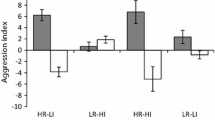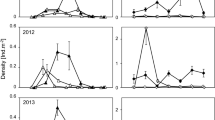Abstract
Stegastes diencaeus and S. dorsopunicans are mutually territorial Caribbean damselfishes. S. diencaeus is larger, grows faster and lives longer than S. dorsopunicans. S. diencaeus is a habitat specialist that shares its primary habitat mainly with S. dorsopunicans. Field manipulations show that both S. diencaeus and S. dorsopunicans readily take over living space from smaller, but not larger, heterospecific neighbors. Natural changes in the use of living space by both species occur frequently and adult S. diencaeus often aggressively usurp the living areas of smaller S. dorsopunicans. Lunar and seasonal patterns of juvenile recruitment by S. diencaeus and S. dorsopunicans are similar. Large size bestows competitive superiority on S. diencaeus by giving its adults a superior ability to aggressively acquire living space, and by enabling its juveniles to quickly escape the period when they lack a size advantage. Hence they spend much of their lives as competitive dominants. There is no evidence that competitive advantages arising from large size are offset either by other adult attributes or by differences in temporal patterns of recruitment that affect priority of access to space. The lottery hypothesis for species coexistence relies on patterns of abundance being determined by patterns of recruitment to vacant space because different species have equal space-holding abilities. These data show that the existence of such a mechanism is doubtful.
Similar content being viewed by others
References
Abrams PA (1984a) Recruitment, lotteries, and coexistence in coral reef fish. Am Nat 123: 44–55
Abrams PA (1984b) Variability in resource consumption rates and the coexistence of competing species. Theor Popul Biol 25: 106–124
Allen GR (1991) Damselfishes of the world, 2nd edn. Mergus, Melle, Germany
Anderson GRV, Ehrlich AH, Ehrlich PR, Roughgarden JD, Russell BC, Talbot FH (1981) The community structure of coral reef fishes. Am Nat 117: 476–495
Batschelet (1981) Circular statistics in biology. Academic Press, New York
Blueweiss L, Fox H, Kudzma V, Nakashima D, Peters R, Sams S (1978) Relationships between body size and some life history parameters. Oecologia 37: 257–272
Buesa RJ (1987) Growth rate of tropical demersal fishes. Mar Ecol Prog Ser 36: 191–199
Calder WA III (1984) Size, function and life history. Harvard University Press, Cambridge, Mass
Chatfield C (1984) The analysis of time series: an introduction, 3rd edn. Chapman and Hall, New York
Chesson PL (1984) The storage effect in stochastic population models. Math Ecol 54: 76–89
Chesson PL (1985) Coexistence of competitors in spatially and temporally varying environments: a look at the combined effects of different sorts of variability. Theor Popul Biol 28: 263–287
Chesson PL (1991) A need for niches? Trends Ecol Evol 6: 26–28
Chesson PL (1994) Multispecies competition in variable environments. Theor Popul Biol 45: 227–276
Chesson PL, Warner RR (1981) Environmental variability promotes coexistence in lottery competitive systems. Am Nat 117: 923–943
Clarke RD (1977) Habitat distributions and species diversity of chaetodontid and pomacentrid fishes near Bimini, Bahamas. Mar Biol 40: 277–289
Clarke RD (1989) Population fluctuations, competition and microhabitat distributions of two species of tube blennies, Acanthemblamaria (Teleostei, Chaenopsidae). Bull Mar Sci 44: 1174–1185
Comins HN, Noble IR (1985) Dispersal, variability and transient niche: species coexistence in a uniformly variable environment. Am Nat 126: 706–723
Doherty PJ (1983) Tropical territorial damselfishes: is density limited by aggression or recruitment? Ecology 64: 176–190
Doherty PJ (1991) Spatial and temporal patterns of recruitment. In: Sale PF (ed) The ecology of fishes on coral reefs. Academic Press, New York, pp 261–293
Doherty PJ, Fowler A (1994) An empirical test of recruitment limitation in a coral reef fish. Science 263: 935–939
Doherty PJ, Williams DMcB (1988) The replenishment of coral reef fish populations. Oceanogr Mar Biol 26: 487–551
Ebersole JP (1985) Niche separation of two damselfish species by aggression and differential microhabitat utilization. Ecology 66: 14–20
Emery RA (1973) Comparative ecology and functional osteology of fourteen species of damselfish (Pisces: Pomacentridae) at Alligator reef, Florida Keys. Bull Mar Sci 23: 649–770
Foster SA (1985) Size-dependent territory defense by a damselfish. Oecologia 67: 499–505
Kodric-Brown A (1990) Mechanisms of sexual selection: insights from fishes. Ann Zool Fenn 27: 87–100
Legrende M, Albaret JJ (1991) Maximum observed length as an indicator of growth rate in tropical fishes. Aquaculture 94: 327–341
Loreau M, Ebenhoh W (1994) Competitive exclusion and coexistence of species with complex life cycles. Theor Popul Biol 46: 58–77
Robertson DR (1984) Cohabitation of competing territorial damselfishes on a Caribbean coral reef. Ecology 65: 1121–1135
Robertson DR (1987) Responses of two coral reef toadfishes (Batrachoididae) to the demise of their primary prey, the sea urchin Diadema antillarum. Copeia 1987: 637–642
Robertson DR (1990) Differences in the seasonalities of spawning and recruitment of some small neotropical reef fishes. J Exp Mar Biol Ecol 144: 49–62
Robertson DR (1992) Patterns of lunar settlement and early recruitment in Caribbean reef fishes at Panama. Mar Biol 114: 527–537
Robertson DR, Gaines SG (1986) Interference competition structures habitat use in a local assemblage of coral reef surgeonfishes. Ecology 67: 1372–1383
Robertson DR, Lassig B (1980) Spatial distribution patterns and coexistence of a group of territorial damselfishes from the Great Barrier Reef. Bull Mar Sci 30: 187–203
Robertson DR, Sweatman HPA, Cleland MG, Fletcher EA (1976) Schooling as a mechanism for circumventing the territoriality of competitors. Ecology 57: 1208–1220
Robertson DR, Schober UM, Brawn JD (1993) Comparative variation in spawning output and juvenile recruitment of some Caribbean reef fishes. Mar Ecol Prog Ser 94: 105–113
Root RB (1967) The niche-exploitation patterns of the blue-gray gnat catcher. Ecol Monogr 37: 317–350
Sale PF (1974) Mechanisms of coexistence of a guild of territorial fishes at Heron Island. Proc 2nd Int Symp Coral Reefs 1: 207–216
Sale PF (1975) Patterns of use of space in a guild of territorial reef fishes. Mar Biol 29: 89–97
Sale PF (1976) Reef fish lottery. Nat Hist 85: 60–65
Sale PF (1977) Maintenance of high diversity in coral reef fish communities. Am Nat 111: 337–359
Sale PF (1978) Coexistence of coral reef fishes — a lottery for living space. Environ Biol Fish 3: 85–102
Sale PF (1979) Recruitment, loss, and coexistence in a guild of territorial coral reef fishes. Oecologia 42: 159–177
Sale PF (1980) The ecology of fishes on coral reefs. Oceanogr Mar Biol 18: 367–421
Sale PF (1982) Stock-recruitment relationship and regional coexistence in a lottery competitive system: a simulation study. Am Nat 120: 139–159
Sale PF (1991) Reef fish communities: open nonequilibrial systems. In: Sale PF (ed) The ecology of fishes on coral reefs. Academic Press, New York, pp 564–598
Sale PF, Dybdahl R (1978) Determinants of community structure for coral reef fishes in isolated coral heads at lagoonal and reef slope sites. Oecologia 34: 57–74
Shulman MJ (1985) Coral reef fish assemblages: intra- and interspecific competition for shelter sites. Environ Biol Fish 13: 81–92
Sokal RR, Rohlf FJ (1981) Biometry: the principles and practise of statistics in biological research, 2nd edn. Freeman, New York
Talbot FH, Russell BC, Anderson GRV (1978) Coral reef fish communities: unstable high diversity systems? Ecol Monogr 48: 425–440
Victor BC (1986) Larval settlement and juvenile mortality in a recruitment-limited coral reef fish population. Ecol Monogr 56: 145–160
Waldner RE, Robertson DR (1980) Patterns of habitat partitioning by eight species of territorial Caribbean damselfishes (Pisces: Pomacentridae). Bull Mar Sci 30: 171–186
Warner RR, Chesson PL (1985) Coexistence mediated by recruitment fluctuations: a field guide to the storage effect. Am Nat 125: 769–787
Wilkinson L (1990) SYSTAT: the system for statistics. Systat Inc., Evanston, Ill
Williams DMcB (1980) Dynamics of the pomacentrid community on small patch reefs in One Tree Lagoon (Great Barrier Reef). Bull Mar Sci 30: 159–170
Williams DMcB (1991) Patterns and processes in the distribution of coral reef fishes. In: Sale PF (ed) The ecology of fishes on coral reefs. Academic Press, New York, pp 437–474
Author information
Authors and Affiliations
Rights and permissions
About this article
Cite this article
Robertson, D.R. Competitive ability and the potential for lotteries among territorial reef fishes. Oecologia 103, 180–190 (1995). https://doi.org/10.1007/BF00329078
Received:
Accepted:
Issue Date:
DOI: https://doi.org/10.1007/BF00329078




